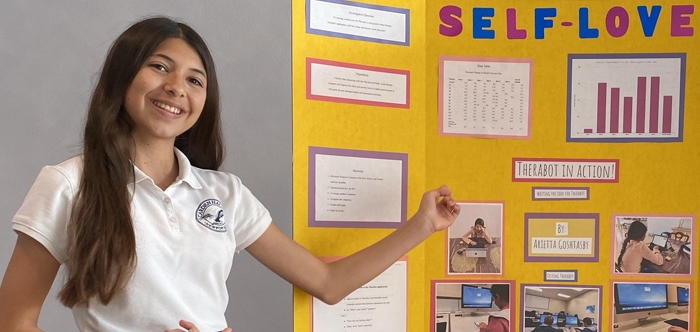
It’s hard for teenagers to separate from their phones. But what if their phones could give them first aid when they experience anxiety? Carden Hall Elementary School Student Arietta Goshtasby has developed an app that reduces anxiety levels for teens. The ‘Therabot’ was first presented at the Orange County Science and Engineering Fair earlier this year, following almost a year of development and trials. It was awarded First Place (Junior) in Behavioral Sciences category.
“As the daughter of a psychotherapist in training, I am familiar with the field and the overall outline of a therapy session,” Goshtasby says. “What I found most fascinating was that therapists are taught not to give their client the answer, but to guide the client to his or her own personal answer. The therapist’s main job is to listen to the clients so that they can express his emotions freely. I realized that the therapist is not always needed to get to that point of self-discovery. I’ve heard of therapists using methods of self-assessment, such as journaling, as a more private way to encourage personal reflection in their clients. That was primarily the inspiration for Therabot.”
Arietta’s idea for ‘Therabot’ was inspired by her and her friends’ experience with anxiety. Sometimes, the urge to talk to someone, or to check yourself, is overridden by shame. “A lot of times, I or one of my friends would be having a bad day and not want to talk about it for fear of embarrassment, sounding overdramatic, or being misunderstood,” she says. “Because of it, at least for me, I would often find myself held back from focusing in class and connecting with other students, two very important things in a good education. These instances are what I had in mind when creating Therabot.”
“With the program, we can express what happened that day, what made us feel a certain way, and how we can learn from today’s mistakes for a better tomorrow without holding back or being afraid of judgement. Think of it as a deep cleaning; when you finish, not only do you feel better about yourself, but you may have found a forgotten something that was the root of your problems. In our case, it may have been stimulating negative thoughts, which lead to negative behaviors. These things are normal, but it is essential to eliminate them so the student can move forward in life with full potential.”
Following the first year of development and trial, which she laid out in her OCSEF project, ‘Therabot’ has been proven to reduce the stress level “score” based on assessments before and after using the program, on a daily basis and overall change from the first to last day. The program guides the user through questions and takes two reports, before and after the questions, in which the user rates his or her mood on a range from one to one hundred. A mood rating of one is equivalent to perceived depression and anxiety, while one hundred is perceived happiness/comfort. Then, Therabot subtracts the initial mood from the final mood. Finally, the program takes the overall average of each day’s result number and classifies the change from the first day by the same positive-zero-negative scale.
“I built the app with popular programming software, Java, over my Christmas break in 2019,” explains Goshtasby. “My grandfather, a retired computer science professor, was visiting, and I would work on it with his assistance. My mother inspired me in making the ‘therapy’ aspect of the application. Not only is the algorithm formulated based on a therapy session, but Therabot’s words are curated to be completely neutral and unoffensive. For instance, the final statement briefly describing how the client has done since using Therabot can be difficult to put into words, because, similar to a therapist, the application has to be straightforward yet delicate, especially for rare cases where the client has had no change or has decreased in their stress level ‘score’.”
When it came to the first trials, Arietta turned to her friends at school to try it out, and got a phenomenal response. “One participant in particular told me that she really enjoyed using the program and did feel an overall change,” she recalls. “This meant a lot to me because I wanted the user to feel relaxed during the process as well as afterward. Students are very busy, so I designed the code keeping in mind that this may be the only five minutes they have to themselves all day. My test trial students often had to rush to and from classes to get to the school computer lab where the project was held. I was really glad that Therabot inadvertently ended up providing a short time of quiet and self-assessment in their long days.”

As the results of the trial came in, Arietta became optimistic about electronic devices’ ability to provide true comfort and ease anxieties for teenagers. “I have three theories as to why Therabot worked so well. Firstly, people find solace in talking about themselves. It is the one thing we know the best, and consequently we learn more about ourselves when we talk about ourselves.”
“Also, my main interpretation of therapy is explaining your problems until you figure out how to cope with them. I built Therabot around this idea, which has been scientifically proven many times to be correct. Lastly, I took this concept of therapy and attempted to make it better. Therapy has such a large stigma around it. Many people think of therapy as only for the insane and not private enough to feel comfortable. Actually, therapy is a healthy thing which promotes mental well-being. However, teenagers in particular can be hesitant to open up to others, especially in a foreign environment. With Therabot I tried to improve upon these things by keeping the interface clean, the questions simple as well as conversational, and deleting the discussion for privacy reasons after each session.”
